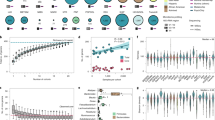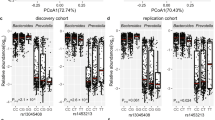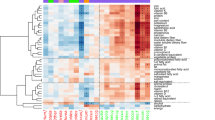Abstract
Human gut microbiota is an important determinant for health and disease, and recent studies emphasize the numerous factors shaping its diversity. Here we performed a genome-wide association study (GWAS) of the gut microbiota using two cohorts from northern Germany totaling 1,812 individuals. Comprehensively controlling for diet and non-genetic parameters, we identify genome-wide significant associations for overall microbial variation and individual taxa at multiple genetic loci, including the VDR gene (encoding vitamin D receptor). We observe significant shifts in the microbiota of Vdr−/− mice relative to control mice and correlations between the microbiota and serum measurements of selected bile and fatty acids in humans, including known ligands and downstream metabolites of VDR. Genome-wide significant (P < 5 × 10−8) associations at multiple additional loci identify other important points of host–microbe intersection, notably several disease susceptibility genes and sterol metabolism pathway components. Non-genetic and genetic factors each account for approximately 10% of the variation in gut microbiota, whereby individual effects are relatively small.
This is a preview of subscription content, access via your institution
Access options
Subscribe to this journal
Receive 12 print issues and online access
$209.00 per year
only $17.42 per issue
Buy this article
- Purchase on Springer Link
- Instant access to full article PDF
Prices may be subject to local taxes which are calculated during checkout



Similar content being viewed by others
References
Ley, R.E., Peterson, D.A. & Gordon, J.I. Ecological and evolutionary forces shaping microbial diversity in the human intestine. Cell 124, 837–848 (2006).
Fraune, S. & Bosch, T.C. Why bacteria matter in animal development and evolution. BioEssays 32, 571–580 (2010).
Sekirov, I., Russell, S.L., Antunes, L.C.B.B. & Finlay, B.B. Gut microbiota in health and disease. Physiol. Rev. 90, 859–904 (2010).
Chow, J. & Mazmanian, S.K. A pathobiont of the microbiota balances host colonization and intestinal inflammation. Cell Host Microbe 7, 265–276 (2010).
Costello, E.K., Stagaman, K., Dethlefsen, L., Bohannan, B.J. & Relman, D.A. The application of ecological theory toward an understanding of the human microbiome. Science 336, 1255–1262 (2012).
Walter, J. & Ley, R. The human gut microbiome: ecology and recent evolutionary changes. Annu. Rev. Microbiol. 65, 411–429 (2011).
Antonopoulos, D.A. et al. Reproducible community dynamics of the gastrointestinal microbiota following antibiotic perturbation. Infect. Immun. 77, 2367–2375 (2009).
Caporaso, J.G. et al. Moving pictures of the human microbiome. Genome Biol. 12, R50 (2011).
Eckburg, P.B. et al. Diversity of the human intestinal microbial flora. Science 308, 1635–1638 (2005).
Qin, J. et al. A human gut microbial gene catalogue established by metagenomic sequencing. Nature 464, 59–65 (2010).
Yatsunenko, T. et al. Human gut microbiome viewed across age and geography. Nature 486, 222–227 (2012).
Goodrich, J.K. et al. Human genetics shape the gut microbiome. Cell 159, 789–799 (2014).
Cotillard, A. et al. Dietary intervention impact on gut microbial gene richness. Nature 500, 585–588 (2013).
David, L.A. et al. Diet rapidly and reproducibly alters the human gut microbiome. Nature 505, 559–563 (2014).
Rehman, A. et al. Geographical patterns of the standing and active human gut microbiome in health and IBD. Gut 65, 238–248 (2016).
Maurice, C.F., Haiser, H.J. & Turnbaugh, P.J. Xenobiotics shape the physiology and gene expression of the active human gut microbiome. Cell 152, 39–50 (2013).
Rausch, P. et al. Colonic mucosa-associated microbiota is influenced by an interaction of Crohn disease and FUT2 (Secretor) genotype. Proc. Natl. Acad. Sci. USA 108, 19030–19035 (2011).
Rehman, A. et al. Nod2 is essential for temporal development of intestinal microbial communities. Gut 60, 1354–1362 (2011).
Blekhman, R. et al. Host genetic variation impacts microbiome composition across human body sites. Genome Biol. 16, 191 (2015).
Krawczak, M. et al. PopGen: population-based recruitment of patients and controls for the analysis of complex genotype–phenotype relationships. Community Genet. 9, 55–61 (2006).
Müller, N. et al. IL-6 blockade by monoclonal antibodies inhibits apolipoprotein (a) expression and lipoprotein (a) synthesis in humans. J. Lipid Res. 56, 1034–1042 (2015).
Biedermann, L. et al. Smoking cessation induces profound changes in the composition of the intestinal microbiota in humans. PLoS One 8, e59260 (2013).
Haussler, M.R. et al. Vitamin D receptor: molecular signaling and actions of nutritional ligands in disease prevention. Nutr. Rev. 66 (Suppl. 2), S98–S112 (2008).
Makishima, M. et al. Vitamin D receptor as an intestinal bile acid sensor. Science 296, 1313–1316 (2002).
Jin, D. et al. Lack of vitamin D receptor causes dysbiosis and changes the functions of the murine intestinal microbiome. Clin. Ther. 37, 996–1009 e7 (2015).
D'Aldebert, E. et al. Bile salts control the antimicrobial peptide cathelicidin through nuclear receptors in the human biliary epithelium. Gastroenterology 136, 1435–1443 (2009).
Sayin, S.I. et al. Gut microbiota regulates bile acid metabolism by reducing the levels of tauro-β-muricholic acid, a naturally occurring FXR antagonist. Cell Metab. 17, 225–235 (2013).
Inoue, Y., Yu, A.M., Inoue, J. & Gonzalez, F.J. Hepatocyte nuclear factor 4α is a central regulator of bile acid conjugation. J. Biol. Chem. 279, 2480–2489 (2004).
Sato, H. et al. Group III secreted phospholipase A2 transgenic mice spontaneously develop inflammation. Biochem. J. 421, 17–27 (2009).
Yano, J.M. et al. Indigenous bacteria from the gut microbiota regulate host serotonin biosynthesis. Cell 161, 264–276 (2015).
Olivares, M. et al. The HLA-DQ2 genotype selects for early intestinal microbiota composition in infants at high risk of developing coeliac disease. Gut 64, 406–417 (2015).
Okada, Y. et al. HLA-Cw*1202–B*5201–DRB1*1502 haplotype increases risk for ulcerative colitis but reduces risk for Crohn's disease. Gastroenterology 141, 864–871 e1, 5 (2011).
Arimura, Y. et al. Characteristics of Japanese inflammatory bowel disease susceptibility loci. J. Gastroenterol. 49, 1217–1230 (2014).
Terao, C. et al. Two susceptibility loci to Takayasu arteritis reveal a synergistic role of the IL12B and HLA-B regions in a Japanese population. Am. J. Hum. Genet. 93, 289–297 (2013).
Benson, A.K. et al. Individuality in gut microbiota composition is a complex polygenic trait shaped by multiple environmental and host genetic factors. Proc. Natl. Acad. Sci. USA 107, 18933–18938 (2010).
Pers, T.H. et al. Biological interpretation of genome-wide association studies using predicted gene functions. Nat. Commun. 6, 5890 (2015).
Phay, J.E., Hussain, H.B. & Moley, J.F. Cloning and expression analysis of a novel member of the facilitative glucose transporter family, SLC2A9 (GLUT9). Genomics 66, 217–220 (2000).
Kliewer, S.A., Umesono, K., Noonan, D.J., Heyman, R.A. & Evans, R.M. Convergence of 9-cis retinoic acid and peroxisome proliferator signalling pathways through heterodimer formation of their receptors. Nature 358, 771–774 (1992).
Repa, J.J. et al. Regulation of absorption and ABC1-mediated efflux of cholesterol by RXR heterodimers. Science 289, 1524–1529 (2000).
Wahlström, A., Sayin, S.I., Marschall, H.U. & Bäckhed, F. Intestinal crosstalk between bile acids and microbiota and its impact on host metabolism. Cell Metab. 24, 41–50 (2016).
Duparc, T. et al. Hepatocyte MyD88 affects bile acids, gut microbiota and metabolome contributing to regulate glucose and lipid metabolism. Gut http://dx.doi.org/10.1136/gutjnl-2015-310904 (2016).
Jostins, L. et al. Host–microbe interactions have shaped the genetic architecture of inflammatory bowel disease. Nature 491, 119–124 (2012).
Liu, J.Z. et al. Dense genotyping of immune-related disease regions identifies nine new risk loci for primary sclerosing cholangitis. Nat. Genet. 45, 670–675 (2013).
Sun, J. VDR/vitamin D receptor regulates autophagic activity through ATG16L1. Autophagy 12, 1057–1058 (2016).
Krude, H., Biebermann, H. & Gruters, A. Mutations in the human proopiomelanocortin gene. Ann. NY Acad. Sci. 994, 233–239 (2003).
Tuoresmäki, P., Väisänen, S., Neme, A., Heikkinen, S. & Carlberg, C. Patterns of genome-wide VDR locations. PLoS One 9, e96105 (2014).
Wang, J. et al. Analysis of intestinal microbiota in hybrid house mice reveals evolutionary divergence in a vertebrate hologenome. Nat. Commun. 6, 6440 (2015).
Srinivas, G. et al. Genome-wide mapping of gene–microbiota interactions in susceptibility to autoimmune skin blistering. Nat. Commun. 4, 2462 (2013).
McKnite, A.M. et al. Murine gut microbiota is defined by host genetics and modulates variation of metabolic traits. PLoS One 7, e39191 (2012).
Leamy, L.J. et al. Host genetics and diet, but not immunoglobulin A expression, converge to shape compositional features of the gut microbiome in an advanced intercross population of mice. Genome Biol. 15, 552 (2014).
Kozich, J.J., Westcott, S.L., Baxter, N.T., Highlander, S.K. & Schloss, P.D. Development of a dual-index sequencing strategy and curation pipeline for analyzing amplicon sequence data on the MiSeq Illumina sequencing platform. Appl. Environ. Microbiol. 79, 5112–5120 (2013).
Magocˇ, T. & Salzberg, S.L. FLASH: fast length adjustment of short reads to improve genome assemblies. Bioinformatics 27, 2957–2963 (2011).
Edgar, R.C., Haas, B.J., Clemente, J.C., Quince, C. & Knight, R. UCHIME improves sensitivity and speed of chimera detection. Bioinformatics 27, 2194–2200 (2011).
Wang, Q., Garrity, G.M., Tiedje, J.M. & Cole, J.R. Naive Bayesian classifier for rapid assignment of rRNA sequences into the new bacterial taxonomy. Appl. Environ. Microbiol. 73, 5261–5267 (2007).
Edgar, R.C. UPARSE: highly accurate OTU sequences from microbial amplicon reads. Nat. Methods 10, 996–998 (2013).
Abu-Hayyeh, S. et al. Prognostic and mechanistic potential of progesterone sulfates in intrahepatic cholestasis of pregnancy and pruritus gravidarum. Hepatology 63, 1287–1298 (2016).
Bjørndal, B. et al. Krill powder increases liver lipid catabolism and reduces glucose mobilization in tumor necrosis factor-α transgenic mice fed a high-fat diet. Metabolism 61, 1461–1472 (2012).
Nöthlings, U., Hoffmann, K., Bergmann, M.M. & Boeing, H. Fitting portion sizes in a self-administered food frequency questionnaire. J. Nutr. 137, 2781–2786 (2007).
Dehne, L.I., Klemm, C., Henseler, G. & Hermann-Kunz, E. The German food code and nutrient data base (BLS II.2). Eur. J. Epidemiol. 15, 355–359 (1999).
Xu, L., Paterson, A.D., Turpin, W. & Xu, W. Assessment and selection of competing models for zero-inflated microbiome data. PLoS One 10, e0129606 (2015).
Degenhardt, F. et al. Genome-wide association study of serum coenzyme Q10 levels identifies susceptibility loci linked to neuronal diseases. Hum. Mol. Genet. http://dx.doi.org/10.1093/hmg/ddw134 (2016).
Purcell, S. et al. PLINK: a tool set for whole-genome association and population-based linkage analyses. Am. J. Hum. Genet. 81, 559–575 (2007).
Ellinghaus, D. et al. Analysis of five chronic inflammatory diseases identifies 27 new associations and highlights disease-specific patterns at shared loci. Nat. Genet. 48, 510–518 (2016).
Wood, A.R. et al. Defining the role of common variation in the genomic and biological architecture of adult human height. Nat. Genet. 46, 1173–1186 (2014).
Bolger, A.M., Lohse, M. & Usadel, B. Trimmomatic: a flexible trimmer for Illumina sequence data. Bioinformatics 30, 2114–2120 (2014).
Schmieder, R. & Edwards, R. Fast identification and removal of sequence contamination from genomic and metagenomic datasets. PLoS One 6, e17288 (2011).
Acknowledgements
We thank A.D. Paterson and colleagues for support in selection of models for GWAS. We further thank Der Norddeutsche Verbund für Hoch- und Höchstleistungsrechnen (HLRN) and S. Knief and H. Marten for computational resources and support. This work was supported by German Research Foundation (DFG) Collaborative Research Center 1182, 'Origin and Function of Metaorganisms' (J.F.B. and A.F.) and Excellence Cluster 306, 'Inflammation at Interfaces' (J.F.B. and A.F.) and by German Federal Ministry of Education and Research (BMBF) project 'SysINFLAME' (J.F.B. and A.F.). Project support was also provided by the Norwegian PSC Research Center and the Western Norway Regional Health Authority (grant 911802) (T.H.K.). M.K. is the recipient of a Postdoctoral Research Fellowship from the German Research Foundation (DFG). J.R.H. was funded by the Norwegian Research Council (240787/F20).
Author information
Authors and Affiliations
Contributions
A.F., J.F.B. and T.H.K. conceived the project. U.N., W.L., M.L. and K.S. organized recruitment and sample collection for the PopGen and FoCus cohorts. Genotyping data were collected and processed by L.B.T., J. Skiecevicˇienė, J.R.H., F.D. and K.H.; nutritional data were generated and processed by S.S., M.P.-J., M. Koch and U.N.; microbiome data were generated and processed by J.W., P. Rausch, F.-A.H., M.C.R., P. Rosenstiel, K.C.-S., S.K. and J.F.B.; and bile acid and fatty acid data were generated and processed by S.A.-D., P.B., R.K.B., M.D'A. and H.-U.M. T.E., J. Sun, J.B., F.S., D.E., M.H., G.R., P.H., W.-H.P., R.S.-T., R.H. and P. Rosenstiel contributed to additional experiments and data for this study. Statistical analyses were performed by J.W., L.B.T., J. Skiecevicˇienė, P. Rausch and M. Kummen, and J.W., L.B.T., J. Skiecevicˇienė, P. Rausch, M. Kummen, J.R.H., M.D'A., H.-U.M., T.H.K., J.F.B. and A.F. interpreted the results. J.W., L.B.T., J. Skiecevicˇienė, P. Rausch, M. Kummen, J.R.H., T.H.K., J.F.B. and A.F. wrote the manuscript, with input from all other authors.
Corresponding author
Ethics declarations
Competing interests
The authors declare no competing financial interests.
Supplementary information
Supplementary Text and Figures
Supplementary Figures 1–19 and Supplementary Note. (PDF 13872 kb)
Supplementary Tables 1–9
Supplementary Tables 1–9. (XLSX 97 kb)
Rights and permissions
About this article
Cite this article
Wang, J., Thingholm, L., Skiecevičienė, J. et al. Genome-wide association analysis identifies variation in vitamin D receptor and other host factors influencing the gut microbiota. Nat Genet 48, 1396–1406 (2016). https://doi.org/10.1038/ng.3695
Received:
Accepted:
Published:
Issue Date:
DOI: https://doi.org/10.1038/ng.3695
This article is cited by
-
Human genetic associations of the airway microbiome in chronic obstructive pulmonary disease
Respiratory Research (2024)
-
A genome-wide association study reveals the relationship between human genetic variation and the nasal microbiome
Communications Biology (2024)
-
Scrutinizing microbiome determinism: why deterministic hypotheses about the microbiome are conceptually ungrounded
History and Philosophy of the Life Sciences (2024)
-
Host genetic regulation of human gut microbial structural variation
Nature (2024)
-
Genome-wide mapping of gene-microbe interactions in the murine lung microbiota based on quantitative microbial profiling
Animal Microbiome (2023)



